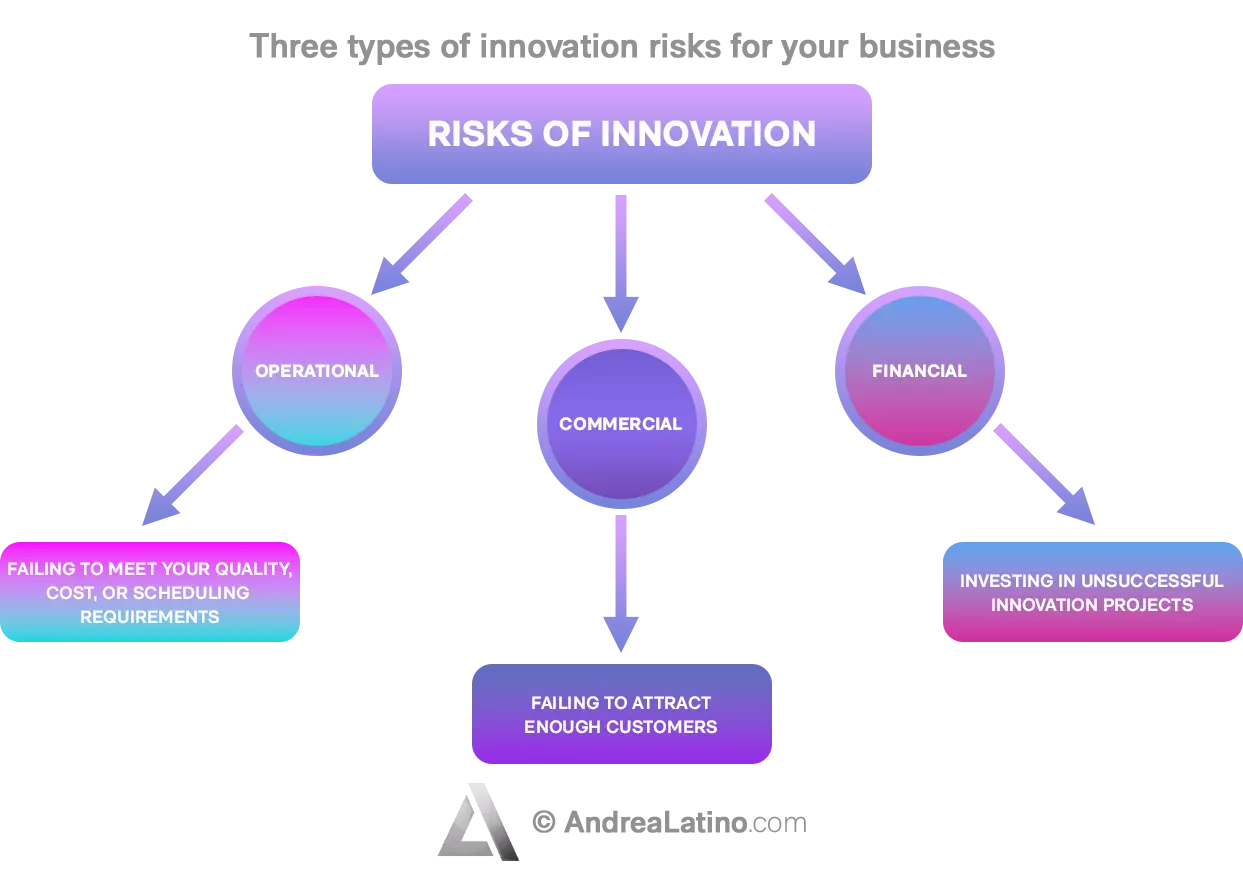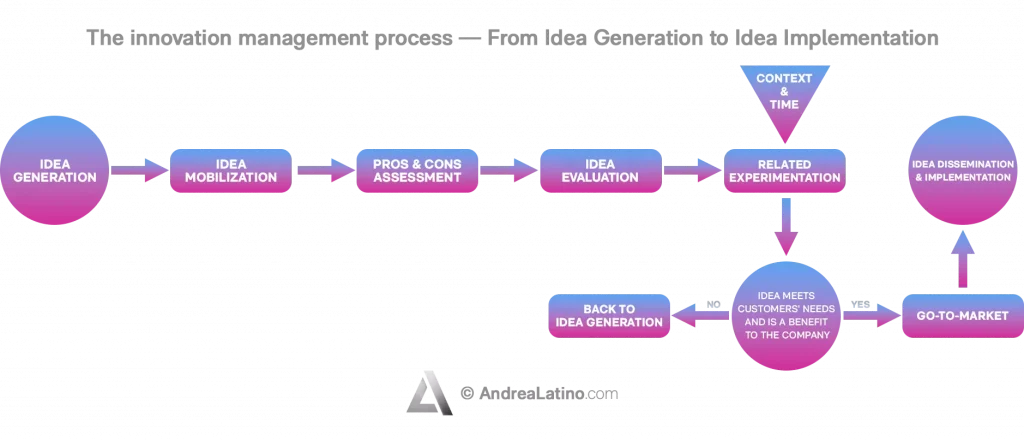Articles & Guides
Innovation Strategy & Innovation Management: best practices and examples
In a nutshell
Find out how to build an Innovation Strategy in 6 easy steps and the importance of Innovation Management: the complete guide with best practices, examples and a downloadable canvas.


Don’t have time to read it all?
Here’s a brief summary of the key points in this guide.
What does an innovation strategy look like, concretely?
There is no marked and predefined path to successful innovation. But fear not: I can give you some guidelines.
- • Start by outlining goals of renewal activities and key initiatives
- • A good strategy is simple, clear, and easily understood by everyone involved
- • It is a bridge between mission, vision, and high-level intent
- • It then translates into the day-to-day activities of the groups responsible for producing impactful results
A great innovation strategy cannot lack these 6 components:
- 1) An ambitious growth mission
- 2) A focused innovation portfolio
- 3) An actionable innovation plan
- 4) A mapped innovation culture to analyze challenges and opportunities
- 5) An innovation capability structured in people, processes, programs and profits
- 6) An optional innovation playbook aimed at indicating methods and tools needed
[DIVE IN]
What about approaches, risks, and challenges?
Commonly, two different applications related to an innovation strategy can be recognized:
- • Business model innovation concerns the development of new concepts to support a company’s financial sustainability
- • The exploitation of the existing business model aspires to set up continuous improvements and sustainable innovations
But innovating also brings pains and risks by its own nature. Risks can be:
- • Operational (failing to meet your quality, cost, or scheduling requirements)
- • Commercial (failing to attract enough customers)
- • Financial (investing in unsuccessful innovation projects)
In short, innovation processes never have an easy life:
- • There never seems to be a good time to invest
- • Isolated measures almost never generate a meaningful and lasting result
- • It is difficult to introduce a collective innovation strategy without extinguishing motivation in employees
[DIVE IN]
How can I build a successful Innovation Strategy?
The 6 steps I suggest compose a relatively solid framework to help develop a sustainable strategy in any organization.
- 1) Evaluate your current capabilities
- 2) Determine your goals and strategic approach
- 3) Align expectations and ambitions for growth
- 4) Study your target market
- 5) Define your Unique Value Proposition
- 6) Determine your innovation techniques and systems
[DIVE IN]
How can I effectively manage Innovation?
The innovation management process requires a new specialized professional figure: the innovation Manager. A profile who:
- • Has leadership skills and strategic vision
- • Is creative, curious, and open-minded
- • Possesses a global view of the market, the company and competitors
- • Can compose balanced management teams
- • Develops organizational capabilities relying on policies and processes
- • Helps sift through different infrastructure options to unearth the right one and execute a portfolio of interconnected approaches
[DIVE IN]
LEARN TO RIDE
Ready to surf the digital wave and become a leader in your industry? Join Execute.Club, where executives and managers like you can access resources, connect with peers, and get the no-nonsense help you need to succeed in the digital era.
Enter the ClubIntroduction
The term “innovation” immediately evokes great creative inventions or disruptive changes to established assets. Yet in business, to innovate does not necessarily mean to make revolutionary changes: it is a verb that can refer to a product, process, organization, service delivery or business model. An innovation strategy is about creating new value that can attract people.
An introduction to Innovation Strategy
It is almost a cliché now to comment on the speed of changes occurring in the digital age, but the pace is sincerely hyper-fast, and companies are struggling to keep up with innovation. The ability to successfully apply strategic, creative and organizational factors is what distinguishes future businesses from the rest of the industry. In fact, every organization innovates, but with different approaches and, as a consequence, different results.
CEOs enthusiastically publicize the importance of innovation, but business leaders are often disappointed by the fruits of their investments, while the world’s top performers approach change strategically. It is not easy, after all, even for large corporations to reinvent themselves as leading innovators: too many habits come to jam and too many cultural aspects suffer from a particularly intrusive multi-year effort.
Formulating an innovation strategy can therefore be daunting, too big even to initiate. Not least because it is an increasingly rapid, interactive process open to an array of internal and external stakeholders. So, any company wishing to embark on a renewal journey with positive outcomes will need to closely study and assimilate the practices of the most skilled high-performance innovators to build an efficient operating system.
What is an Innovation Strategy?

While innovation itself is a complex operation that requires planning and cross-functional practices and processes, a communication strategy is exactly the plan from which new competitive goals are pursued. In short, an innovation strategy is about defining a shared plan that outlines how to allocate resources, structure activities, and employ skills to achieve the best possible outcome to support business growth.
DOWNLOADABLE FILES
- Innovation Strategy Canvas – Download now!
A comprehensive strategy maps the boundaries to expectations, simplifies and punctuates the innovation process to empower managers with the right choices from a range of options thus giving them a better chance of achieving the set goals. According to 96 percent of executives, innovation is a strategic priority. But when business evolution becomes a pressing issue, lack of method remains a problem for even the most established companies.
Best practices and examples
Innovation Strategy: best practices
What does an innovation strategy look like, concretely? This is not to shut down enthusiasm, but there is no marked and predefined path to successful innovation. Every company will have to roll up its sleeves and take responsibility. It is necessary to make choices along the direction considered right, to understand the underlying motivations, to intuit the future global changes that might affect the enterprise and what role innovation would play when dealing with them.
I mean, there is no proven formula for success, and there are no two innovation strategies that are the same. But fear not: there are some guidelines. First, you should start by outlining the goals of renewal activities and the key initiatives through which to achieve them. A good strategy is simple, clear, and easily understood by all involved. In fact, it is essential that everyone has the same map at their disposal and, more importantly, that they know how to read it, in order to align the team toward the same direction and coordinate their maneuvers.
Ultimately, the strategic best practice of corporate innovation is a bridge between mission, vision, and high-level intent. It then translates itself into the day-to-day activities of the groups responsible for producing impactful results. A great innovation strategy cannot lack these 6 components:
1) an ambitious growth mission, complete with mission statement and framework
2) a focused innovation portfolio, including key activities with the greatest business impact
3) an actionable innovation plan (a blueprint for executing initiatives)
4) a mapped innovation culture to analyze challenges and opportunities
5) an innovation capability structured in people, processes, programs and profits
6) an optional innovation playbook aimed at indicating methods and tools needed
Some examples of Innovation Strategy
Apple
Organizations that, year after year, manage to keep up with the times by presenting high standards of modernity, hide clear innovation strategies. Think of Apple, which used to just focus on product development and now instead prioritizes skills development through accelerators and the acquisition of promising startups. For example, Apple Entrepreneur Camp is an external accelerator for women-led organizations aimed at encouraging the proliferation of female entrepreneurs in the technology sector. Meanwhile, the internal accelerator is dedicated to an electric car research project titled “Titan”, which involves about 5,000 employees. Finally, Apple absorbed Xnor.ai, a provider of low-power edge-based AI tools.

Samsung
Now consider Apple’s archenemy, Samsung, whose strategy has traditionally focused on incremental innovation (one example: curved smartphone screens). But in recent years the company has changed its plan of action toward diversifying its portfolio. Today it explores Artificial Intelligence, Internet of Things, autonomous mobility, privacy compliance, and more. And then it strategically invests in a number of external initiatives to co-create business or bet on financially attractive software and services startups. The Samsung Europe team then designs new products for the European market focusing on consumers and trying to convince South Korean executives to put money into them.
And then there is Google, whose renewal initiatives reside entirely in the matrix, which is why it is difficult to identify a single archetype of innovation. We do know, however, that Alphabet, the parent company, invests heavily in R&D, aiming for disruptive, radical, architectural change. Ideas are born and tested inside a semi-secret U.S. facility called X and considered the “Moonshot Factory” (self-driving cars, Google Glass, and Wear OS saw the light here). And to lengthen the list of acronyms and code names, GV (formerly Google Ventures) is the venture capital investment arm that provides seed, venture and growth funding to technology companies operating independently from Google.

Do you have a Strategy & Innovation challenge to tackle? Let’s face it. Together.
C-levels from these companies (AND MORE) relied on my expertise to overcome thEIR CHALLENGES IN THIS AREA. And You can, too.
Can I help you?All you need to know
Innovation strategy: approaches, pains, challenges
Therefore, developing an innovation strategy per se is not necessarily difficult. Most of the time and effort expended, however, may fall on attempts to unify it with overall business goals and working methods. Indeed, it should not be forgotten that only a unified vision and common goals can increase operational effectiveness and avoid the silo effect. The latter indicates the situation that occurs when employees of different departments do not communicate with each other, do not exchange knowledge and skills that would serve to improve the overall end result.
Now, remember this: there is no point in innovating just for the sake of it. Innovation must be part of a larger plan. So, before developing a strategy, make sure you are well aware of the contribution that innovation would make toward achieving the underlying intent. The choice to focus on the best possible way to win is deliberate, but it is always best to be able to justify the reasons for that choice, at least to yourself. The best approach, in this sense, is often to make decisions that are easier to implement than competing on the same playing field.
But innovation also requires actionable and differentiated insights that can excite customers and develop new markets. Unless you are a genius with exceptional creativity, the right insights can emerge from methodical and systematic examination of three factors:
1) a big problem to be solved
2) a technology that could solve it
3) a business model that generates money
Almost all successful innovation comes from their intersection. The process of insight discovery could be called the lifeblood of innovation, especially as it extends beyond the boundaries of the company and engages those partnerships that generate insights.
Two different approaches to innovation strategy
Commonly, two different applications related to an innovation strategy can be recognized: one involves the complete renewal of the business model, the other the exploitation of the existing business model.
Business model innovation concerns the development of new concepts to support a company’s financial sustainability. New concepts that include, among other things, the entrepreneurial mission and the processes required to implement those concepts. In this case, the number one goal is to identify novel sources of revenue by increasing product value and changing the way products are delivered to customers. Business model innovation wants to address the choice of target segment, product or service offering, and revenue model. From an operational perspective, then, efforts are aimed at driving profitability, competitive advantage, and value creation.
The exploitation of the existing business model, on the other hand, aspires to set up continuous improvements and sustainable innovations. In contrast to the previous approach, the strategic focus here is on improving the core business, as well as the main activity of a company, which determines its core tasks. In any case, on the basis of these two typically alternative methods, we can identify three prototypes of innovators: market reader (directs attention toward marketing), need seeker (increases focus toward the consumer) and tech driver (focuses interest toward technology).

Risks and opportunities of an innovation strategy
Most companies do not struggle to identify innovative ideas, but rather to determine which of them can adequately support their opted strategy and goals. It is a problem that typically involves larger companies when faced with market discontinuities: sustaining the next wave of growth always seems very risky until the strenuous change becomes inevitable due to competitive dynamics.
This is because, in fact, innovation is risky by nature. But to get the most out of planned initiatives, risk must be managed rather than eliminated. In fact, no one knows for sure where viable innovations might emerge, and analyzing every area in detail is neither feasible nor cost-effective. Consequently, managers must create boundary conditions for those spaces of opportunity they wish to explore. Identifying and demarcating these spaces can be the result of intuitive visions of the future or carefully delineated strategic analyses.
If companies prioritize spaces in a reasoned manner, they will then be able to assess whether the available resources allow them to invest in the opportunities they deem most valuable. After that, it will be necessary to establish a regime of transparency about ongoing activities and a governance process capable of consistently estimating timing, risks, expected values, and the overall status of the implemented strategy.

What are the difficulties related to the innovation strategy?
Innovation processes never have an easy life. If management is far too cautious, for example, the stifling bureaucracy in marketing, law and other areas can find any reason to slow down or even stop approvals. And it often ends up with the companies themselves putting a spoke in their wheels: initiatives scattered unchecked around the company, lack of top-down support and dialogue, no alignment on priorities in the management team, lack of understanding of what innovation could mean for the company, total focus on technology, and so on.
Indeed, sometimes it turns out that the most impressive innovations are due to the insistence of mavericks who have managed to bypass time-consuming approval processes. Obviously, there is a bureaucratic balance to maintain, but the rush to market in any case should not harm internal collaboration, continuous learning cycles, and pro-innovation decision paths. Managers need to be able to make crucial decisions early on: a company, for example, might decide to test a promising idea on customers at the beginning of the process, in order to anticipate any changes imposed from the inside and overcome the obstacles that stand between a great idea and the final recipient.
Innovation strategy: three complicated challenges
Eighty-five percent of management groups believe that innovation is the key to a company’s success, but almost half of them feel the risk of the process being interrupted. After all, tough economic times are matched by scarcity of resources, and so investing in innovation is out of the question (cost reduction and maintaining market share come first). Yet, when the economy expands and resources are available, the focus struggles to deviate from core business management, as people try to meet demand, provide products and services, and fight old and new competitors. In short, there never seems to be a good time to invest: paradoxically, corporate growth objectives work against innovation.
Innovation generates enthusiasm within organizations, especially in people who see it as a crucial step for the future of their work. This leads to well-intentioned but too individualistic or improvised initiatives. Therefore, a challenge here is to introduce a collective innovation strategy without extinguishing motivation in employees convinced they are doing the right thing for the good of the company and of themselves. However, 75 percent of large organizations do not have well-structured innovation processes, so innovation remains predominantly “ad hoc”.
Companies often act in the hope that implementing tools and solutions individually will somehow make them innovative and trigger an internal cultural revolution. But it should be clear by now that isolated measures almost never generate a meaningful and lasting result. It is the so-called “silver bullet syndrome“. Sound approaches such as design thinking, business model innovation, the Lean Startup method or idea management systems are not enough: a broader plan is needed for them to be truly effective, otherwise the enthusiasm for innovation fades quickly.
How can an innovation strategy go wrong?

In order for an innovation strategy to be successful, the alignment of five specific factors must be checked: vision, skills, incentive, resources, and an action plan. Change really happens when a company can bring each of these elements into play. But let’s have a closer look to the other possible outcomes.
When a company lacks of vision (i. e., the company’s inspirational and aspirational purpose which defines its primary long-term goals), strategy can only follow a confusing path that will lead nowhere.
If the available workforce does not have adequate skills to support innovation, a feeling of anxiety and haste will take over.
No incentives? I bet you hear loudly uttered the most classic and deleterious “but we have always done it this way”. Plug your ears against resistance.
Unfortunately, and as usual, a large amount of money is also necessary. Lack of cash resources when all other elements are in place inevitably leads to frustration. You can’t do anything about it, you feel helpless.
And finally, if your innovation strategy is not paradoxically matched with an action plan, you will keep repeating the same things (and the same mistakes) over and over again. This is the treadmill situation.
The importance of engaging employees
The only way to enable your organization to innovate for a long time is to ensure that vision, skills, incentives, resources, and an action plan, are fully incorporated into an all-encompassing business strategy. Also, no matter how ambitious the latter is – it will not succeed without the active and conscious input of employees in management processes. The best companies always find ways to amalgamate innovation among the fibers of their culture and spread it from the center to the periphery, focusing minds in the same direction.
CEOs recognize the importance of innovation but often underestimate consensus and alignment of the executive team (although, in some cases, it is the top managers themselves who do not realize the significance, scope, and possible consequences of innovation). If senior officials fail in top-down communication, a good strategy will fail as well. Innovation leaders, on the other hand, must use active communication to engage and clarify responsibilities, offering the appropriate rewards and incentives.
Working on real innovation with multiple teams – perhaps making sure they are always enjoying new blood or verifying that they have assimilated lessons from successes and failures – allows them to develop individual and group faculties, hence value. Resign yourselves: internal collaboration (especially when it comes to experimentation) can take years to become established, especially in mature companies with entrenched cultures and ways of working. But it remains for companies the duty to help people share ideas and knowledge freely.
The role of external collaborators
It only took a few years, moreover, for companies in almost every industry to admit the need for outside collaborators. What’s more, smart cooperation goes far beyond the search for ideas and insights: it can foster cost sharing and shortcuts to market.
Consider Apple’s successful management of external partnerships: almost all the components of the first iPod model were developed outside the company, and the initial idea was thus transformed into a marketable product within just nine months.
This means that savvy innovators surround themselves with a network of contacts that can be widened or narrowed as desired. Thus, they resort to sophisticated incentives and contractual structures to stimulate high-performing business associates.
6 steps to build an Innovation Strategy
How to build an innovation strategy in 6 simple steps
Knowing how to make the right choices enables you to transform the formulation of an innovation strategy from a cumbersome, messy, and divisive task to a simple and systematic exercise. The 6 steps I suggest compose a relatively solid framework to help develop a sustainable strategy in any organization.
1) Evaluate your current capabilities
An innovation strategy starts with classic, in-depth and indispensable self-knowledge. Check, then, the effectiveness of the main innovation capabilities you already have and identify areas for improvement. To understand where you are now you will need to use both quantitative and qualitative research methods, considering, in particular: culture, R&D, behaviors, values, knowledge, skills. For example, if you want to succeed by providing a breakthrough technology, make sure you have the internal skills to be able to build it.
2) Determine your goals and strategic approach
It will help you make decisions about how to allocate resources and understand whether you are investing too much or too little in the right types of innovation for growth. Then ask yourself what you want to achieve and why you want to innovate. And, at this point, be sure to align your innovation strategy with your business goals: it is one of the most difficult tasks but quantifying a purpose and making it an explicit part of future strategic plans helps solidify the importance of innovation. Indeed, the goal itself should be broad enough to compel managers to include investments in innovation in their business plans.
3) Align expectations and ambitions for growth
Certain outcomes should flow from an innovation strategy, but we should establish now what we expect to achieve (it is from misguided or delayed setting of expectations that much of the disappointment comes). Expected outcomes should not only be financial, but also involve other dimensions such as category leadership, social impact, or new economic models. A balance must be struck between core business management and renewal. This is a complicated problem that could be solved by a proper allocation of resources. Then it is important to align on the time frame when the actual impact on the business or ROI on the innovation investment is expected.
4) Study your target market
Innovation cannot be achieved without knowledge of the playing field occupied by customers and competitors. To arrange the strategy in line with the company’s vision and mission, you must first analyze the external and internal factors that could influence it. Innovating while remaining responsive to customers comes from listening to and understanding their real needs. But even before that, it is necessary to know what is happening in the marketplace. Keep in mind, however, that competitive needs are individual and specific, so a strategy that worked for another player in the same industry should not be copied but simply used as a reference.
5) Define your value proposition
Knowing the playing field is important, but the Unique Value Proposition (UVP) is what can really determine – or destroy – your innovation strategy. It is the factor that will grant you a competitive advantage (i.e., to achieve the goal of innovation). You will need to focus, then, on creating value that will save customers time and money or make them willing to pay more for your offering. In this regard, it would be ideal to be able to identify new unchallenged markets through value innovation that makes the competition irrelevant. And success can be achieved by differentiating existing products and services and reducing their costs.
6) Determine your innovation techniques and systems
Finally, you will need to figure out how you are going to achieve success with your initiative: what systems are you going to put in place to support the advancement of the strategy, what techniques are you going to need to connect the elements of an innovation infrastructure, what metrics are you going to use to measure the results you achieve. In short, all the details need to be ironed out: people, resources, funding, KPIs, teams, and so on. Techniques and systems will need to ensure that a new product or service can be delivered quickly at the desired volume and quality. Thus, production facilities, suppliers and distributors will also have to go through a fast and complete implementation.
Yeah, but…
Why launch an innovation strategy?
Innovating a business model or exploiting the existing business model in an innovative sense are two ways to intervene in the value chain, diversify profit streams, and change delivery patterns.
If an established corporation does not reinvent its patterns on its own, it will let digital-driven latecomers take over. Nevertheless, most large corporations do not want to mess with their beloved business model until the threat appears. At that point, better hope it is not too late.
An innovation strategy, on the other hand: guides and defines a company’s goals, assists in making the right choices to build organizational and individual capabilities, and most importantly, helps define the key changes to be made.
Managing the future
What is innovation management?

The digitalization of processes has forced organizations to mobilize in order to dig up new professional figures of recent appearance. Coordinating innovation, as we have seen, requires a structured process that collectively involves every function and every business department. Achieving the enterprise’s goals requires working together, as a team. And that is where innovation management takes over, being the management of the entire innovation process.
If all the activities necessary to renew an organization are not conducted organically, it will be difficult to innovate effectively. This is why innovation management is a top priority for today’s companies. It needs an articulated system of processes, techniques, and tools that ensures collaboration between managers, Human Resources, and the different departments (technical, sales, marketing, R&D), as well as creating a dedicated multidisciplinary team.
Innovation management: what is it for?
The importance of innovation management has been recognized, defined and certified by the Technical Committee of the International Organization for Standardization (ISO/TC). The goal is to standardize the processes that should ensure proper innovation management. Processes that prioritize, perform evaluations, and validate new ideas, but that – legitimately – may take months or even years to pay off.
An innovation management process begins with generating and mobilizing ideas, meaning moving them from the department where they originated to other areas of the company. After that, their pros and cons are weighed against the objectives and possibilities, right down to an attempt at experimentation related to the particular time and context. If the ideas meet the needs of customers and are a benefit to the company, then they can go to market. Finally, the innovation can be disseminated and implemented, i.e., routinely accepted and executed through the necessary structures and resources.
A critical consideration: never regard innovation as “something that happens” due to the genius of one or more innovators. It is, if anything, the result of a deeply examined and extremely detailed process. It is the result of coordination and cooperation among business departments to foster the digitalization of processes and services, under the supervision of an innovation manager.
Innovation manager: who are they and what do they do?
The innovation management process requires, as mentioned, a new specialized professional figure. A profile designed by the Digital Transformation Academy of Politecnico di Milano according to the following characters: explorer, evangelist, and enabler, with leadership skills and strategic vision. This is the innovation manager (I would add: creative, curious and open-minded).
The ideal candidate is usually someone who constantly seeks out new opportunities, inspires people and guides them toward change. Then, they possess a global view of the market, the company and competitors, and can compose balanced management teams. It does not matter what field they come from, but that they have a multidisciplinary approach and are familiar with the whole company.
Innovation leaders develop generalized organizational capabilities relying on policies and processes. Without a specialized figure, it is difficult for a company to already have the innovation faculties needed to shape its growth ambitions. An innovation manager helps sift through different infrastructure options to unearth the right one and execute a portfolio of interconnected approaches.
Conclusion
Innovation makes us think about the future. Artificial Intelligence, for example, will be one of the great challenges in this field and promises to radically change the way it is managed. Indeed, machines are becoming increasingly creative and are intervening in fields such as design and text generation. The teams that come into existence are also changing: they are getting smaller and smarter, agile, lacking traditional hierarchies, and united by an idea or goal (making them flexible and adaptable).
To enable business innovation, the right mindset must be adopted in order to allow strategic alignment and seamless integration with how the business works. The right strategy makes it possible to pick the most thoughtful choice from a range of possible options and then test and validate the selected approach. Success begins with a combination of knowledge, practice and hard work.

An important message for you
Hi there! I hope you found this article insightful.
Allow me to introduce myself. I’m Andrea Latino, the author of this article.
I have spent over a decade earning the trust of world-class multinationals, institutions and startups for their digital and innovation initiatives.
Are you curious about my story and how I could help you?
See how I can help youStay in wonderland
Let me show you how deep the rabbit hole goes.
Here are more Articles & Guides:

Articles & Guides
Digital Communication: how to develop an effective one
March 15, 2023

Articles & Guides
Digital Political Communication: doing politics in the age of social media
March 15, 2023

Articles & Guides
Digital PR: public relations in the digital age
March 15, 2023

Articles & Guides
Digital Public Affairs: how to employ effective institutional communication
March 15, 2023

Articles & Guides
Digital Transformation for Human Resources: stages, tools and new skills
March 15, 2023

Articles & Guides
Editorial Plan: how to build a winning one
March 15, 2023

Articles & Guides
Employee Journey: how to track employee experience in 6 simple steps
March 15, 2023

Articles & Guides
Innovation Strategy & Innovation Management: best practice and examples
March 15, 2023

Articles & Guides
Digital Tools & Innovation Resources: the best sources for your innovation process
March 15, 2023
